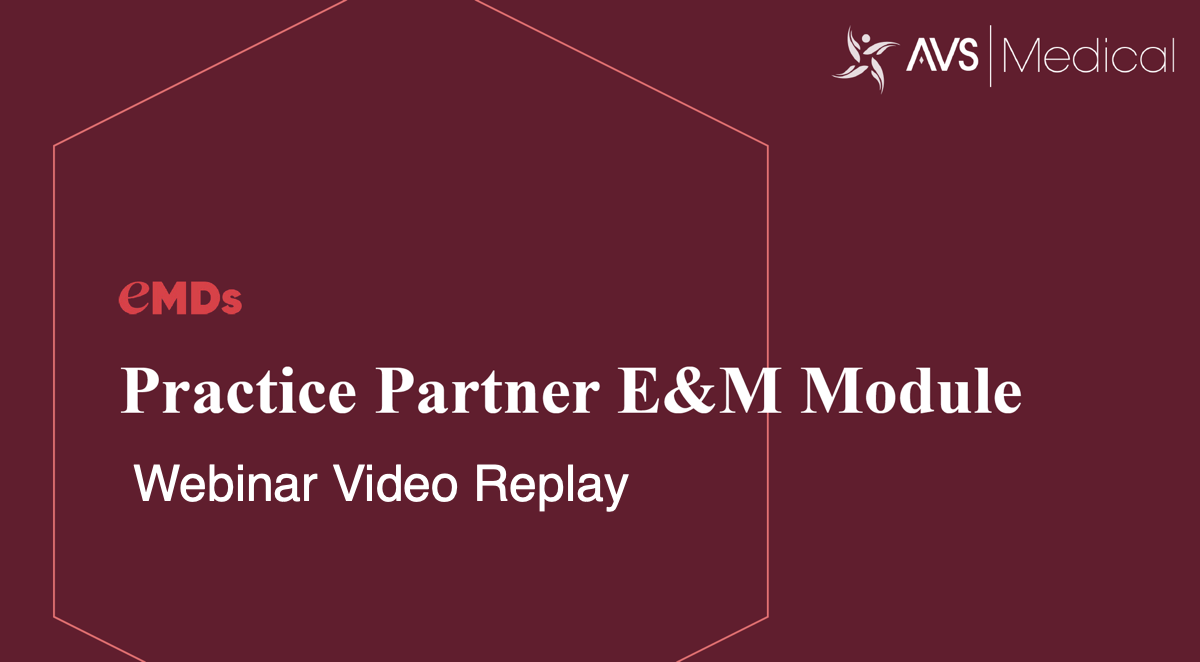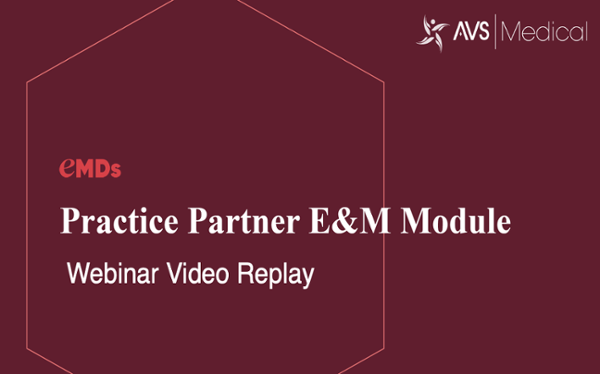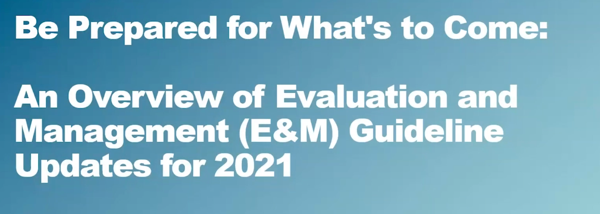How the new Decision Support Intervention Criteria Impacts your EHR
The Decision Support Interventions Certification Criterion The HTI-1 final rule adopts the Decision Support Interventions (DSI) certification...

Starting January 1st 2021 the new CMS Evaluation and Management or E/M coding scheme goes into effect for outpatient visits. A long overdue and welcome change for providers who are tired of counting bullet points to drive the final code.
Following is a detailed description of the changes along with a video replay of a recent Practice Partner E/M 2021 Changes Webinar and a copy of the slides.

This is the first major overhaul of the outpatient E&M services in over 25 years. The stated purpose is to reduce the administrative burden on providers, give them more time to spend with patients and provide compensation for non-face to face patient care that in the past has not been reimbursed.
Starting on the first of the year providers will now choose an E&M code based on either Medical Decision Making (MDM) OR time spent by the provider on the date of the encounter. You’ll have the option to report the E&M code that is most financially advantageous to the practice, and as an added bonus if the proposed rule becomes final the payments will increase over the prior year.
E/M Changes Overview:
* 2021 Changes to History and Exam
Medical Decision Making in 2021
MDM in 2021 will be similar to but not identical to the current MDM calculations. The same four levels still apply:
However the new MDM table includes easier to understand requirements. Furthermore ambiguous terms like “mid’ have been removed and important terms like “independent historian” have been clearly defined.

Let’s take a deeper dive into the new MDM table and explore some of the definitions.
One element in the level of code selection for an office or other outpatient service is the number and complexity of the problems that are addressed at an encounter. Multiple new or established conditions may be addressed at the same time and may affect medical decision making.
Comorbidities/underlying diseases, in and of themselves, are not considered in selecting a level of E/M services unless they are addressed and their presence increases the amount and/or complexity of data to be reviewed and analyzed or the risk of complications and/or morbidity or mortality of patient management.
The final diagnosis for a condition does not in itself determine the complexity or risk, as extensive evaluation may be required to reach the conclusion that the signs or symptoms do not represent a highly morbid condition. Multiple problems of a lower severity may, in the aggregate, create higher risk due to interaction.
Problem Defined
Independent Historian
Independent historian(s): An individual (eg, parent, guardian, surrogate, spouse, witness) who provides a history in addition to a history provided by the patient who is unable to provide a complete or reliable history (eg, due to developmental stage, dementia, or psychosis) or because a confirmatory history is judged to be necessary. In the case where there may be conflict or poor communication between multiple historians and more than one historian(s) is needed, the independent historian(s) requirement is met.
Appropriate Source
Appropriate source: For the purpose of the Discussion of Management data element, an appropriate source includes professionals who are not health care professionals, but may be involved in the management of the patient (eg, lawyer, parole officer, case manager, teacher). It does not include discussion with family or informal caregivers.
Risk
Risk: The probability and/or consequences of an event.The assessment of the level of risk is affected by the nature of the event under consideration.
Definitions of risk are based upon the usual behavior and thought processes of a physician or other qualified health care professional in the same specialty. For the purposes of medical decision making, level of risk is based upon consequences of the problem(s) addressed at the encounter when appropriately treated.
Risk also includes medical decision making related to the need to initiate or forego further testing, treatment and/or hospitalization
Social Determinants of Health
Economic and social conditions that influence the health of people and communities. Examples may include food or housing insecurity.
Drug therapy requiring intensive monitoring for toxicity: A drug that requires intensive monitoring is a therapeutic agent that has the potential to cause serious morbidity or death. The monitoring is performed for assessment of these adverse effects and not primarily for assessment of therapeutic efficacy.
Using Time to Decide the Level of E/M Code
As previously mentioned you have the option to use either MDM or Time to determine your code. How you measure time and when you can use time, and what activities are counted as time have changed from 2020 to 2012 in a way that is fairer, simpler and more financially reasonable.
Time - Overview
Time - Detailed View
In the past a provider could only consider time as a deciding factor when the total time was designated as counseling, coordination of care or both took up more than 50% of the encounter.
Now, time refers to the total time spent with the patient or patient's family for both face to face and non-face to face time spent by the E/M provider on the day of the encounter.
Specific examples include:
communicating results to the patient/family/caregiver
Each 2021 office or outpatient E/M code level will specify the time range that applies to the code:
New patient codes:
99202: 15-29 minutes
99203: 30-44 minutes
99204: 45-59 minutes
99205: 60-74 minutes
Established patient codes:
99212: 10-19 minutes
99213: 20-29 minutes
99214: 30-39 minutes
99215: 40-54 minutes
Definitive Guide to Documenting Time in 2021 E/M

Prolonged Services
There are two new codes 99354-99357 that are used when a physician or other qualified healthcare professional provides prolonged service(s) involving direct patient contact that is provided beyond the usual service in either the inpatient, observation or outpatient setting, except with office or other outpatient services will be greatly simplified. Face-to-face and non-face-to-face services on the day of the visit count. This service is reported in addition to the primary procedure.
When submitting a level 5 visit (99215 or 99205) you can add these codes for each additional 15 minutes of time spent.

The Decision Support Interventions Certification Criterion The HTI-1 final rule adopts the Decision Support Interventions (DSI) certification...

1 min read
On November 2, 2023, the Centers for Medicare and Medicaid Services (CMS) released the2024 Medicare Physician Fee Schedule (PFS) Final Rule, which...

There are some big and exciting changes ahead for E&M Coding in 2021! Starting January 1st 2021 the new CMS Evaluation and Management or E&M coding...